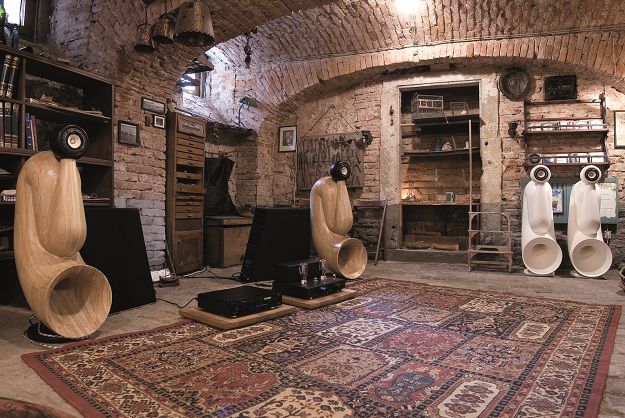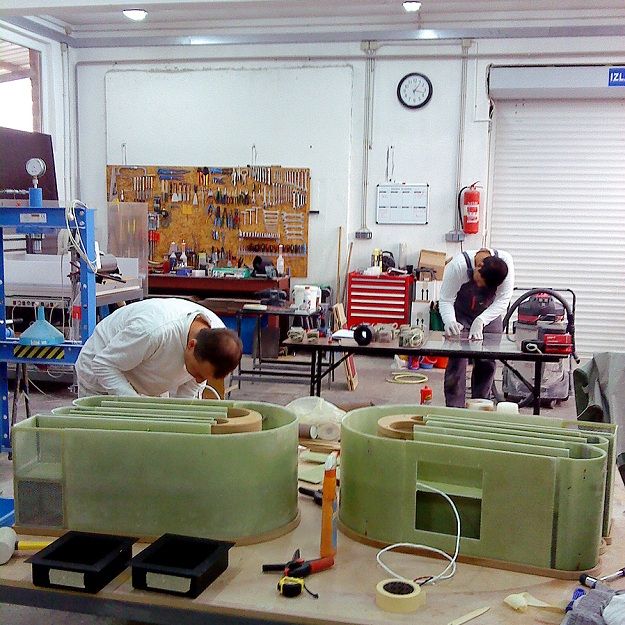The sound of horn speakers depends on calculation and production, while materials are secondary – they can be made from various materials – as long as they are acoustically dead.
“Whether it’s Šostakovič, Brahms or Liszt – every note is audible in full,” said renowned Croatian pianist Lovro Pogorelić in rating the speakers constructed by Goran Tomljenović, doctor of veterinary medicine, who fell in love with physics during his studies, the basis for the construction of his horn speakers – some of the best in the world, as Index.hr wrote on February 4, 2018.
The first thing to notice about these speakers is the unusual design which is simple and functional, but quite a leap from the average. There are no ornaments or unnecessary additions – everything is subordinate to attaining perfect sound.
Tomljenović’s speakers are made from wood, composite materials or even ceramics, but as construction is quite complex and demands several hundred hours of labor, the price of a set is between 15 and 20 thousand euro. Not for everyone, but there are admirers of perfect sound who purchase them – abroad, but also in Croatia, sold by Audio Cinema Art from Mesnička Street in Zagreb.
“My basis and great love in this story is physics. There are various topologies of audio systems. There is bass reflex, compression boxes, transmission boxes… What we are building here is a horn. With horn speakers the significance is one membrane which vibrates the space behind it and a channel which exponentially widens to its end and linearizes wave lengths. When vibrating a membrane, a certain noise vibrates at 200 Hz, another noise with 250 Hz, a third with 400 Hz. The channel in the horn linearizes them all to 0. So within the audible wave lengths from 16Hz to 16 kHz everything is at relatively the same volume. This is what the horn channel is for. With other speaker topologies this is achieved with electronic elements, within the baffle board, resistors, capacitors etc. In the horn it is all one mechanical channel. Our horns have no electrical parts. Only one cable to that membrane, and the horn will linearize all frequencies the membrane produces. And the basis of it all is physics. There is a line of formulas used to calculate this,” says Tomljenović.

“I am a doctor of veterinary medicine, although not in the field at the moment. Physics was an important course in school and as a student I explored the theory of acoustics. Slowly I developed that interest together with electrical engineering colleagues and we arrived at a series of formulas to calculate the linearity of speakers in the horn topology. And through a series of empirical formulas we made some models, perfected them, measured… There is a plethora of instruments to do this, and now we have a winning combination of formulas to calculate the linearity of the horn regardless of the technical specifications of the membrane itself. The speaker as such, found in a sphere at the top, is a full range speaker which vibrates the entire frequency range, and the horn then linearizes it to enter into the sphere of ultimate hi-fi. This is the top of the line. There are maybe a dozen companies in the world producing such horns,” says Tomljenović.
Tomljenović notes the hi-fi world went through a large delayering. Mainstream products are completely gone, with superior products or those for mass consumption remaining, the latter made mostly in China.
“It is still quite an expensive product, but is has its clientele. There is no mass production of it, but there are music aficionados who only buy horns. Generally in the hi-fi world, the ultimate hi-fi is more expensive than ever. Mainstream is completely gone, while there are mass production products made mostly in China and acceptable to a large number of people. Hi-fi is in a tough position, but there is a certain number of people who cherish it,” Tomljenović added.
The sound of horn speakers depends on calculation and production, while materials are secondary – they can be made from various materials – as long as they are acoustically dead.

Production goes on in the Tehnotrik company in Sveta Nedelja near Zagreb. Tomljenović claims they are great experts in material technology headed by Vjekoslav Zelehovski and Danijel Lacković. There is also Nenad Petris, electrical engineer, who uses instruments and his own experience to measure and fine tune the complete acoustic parameters of the system.
“Material is not crucial to us, it can be made from wood, composite materials, ceramics… The sound depends on the calculation of the horn channel and production. It has to be made to two decimal spaces, with very high precision which will result in good sound. The material must have a resonation frequency below the audible spectrum. What matters is that the channel emits the wave lengths we choose,” says Tomljenović.
Translated from Index.hr.








